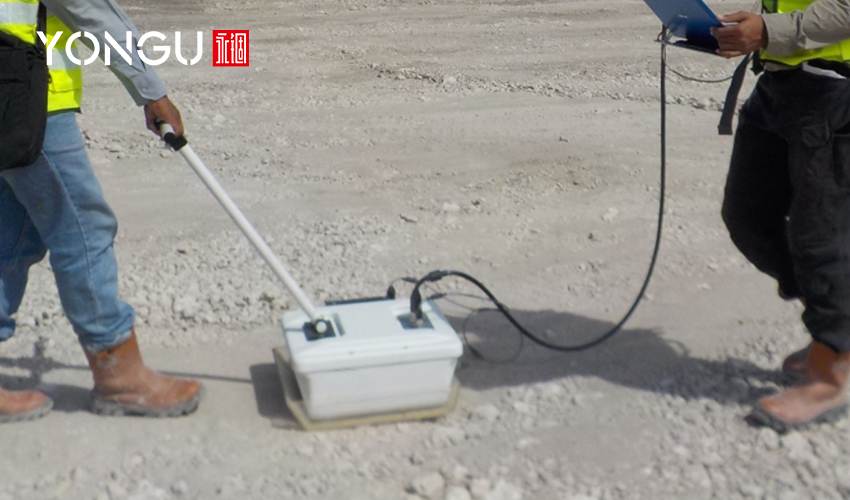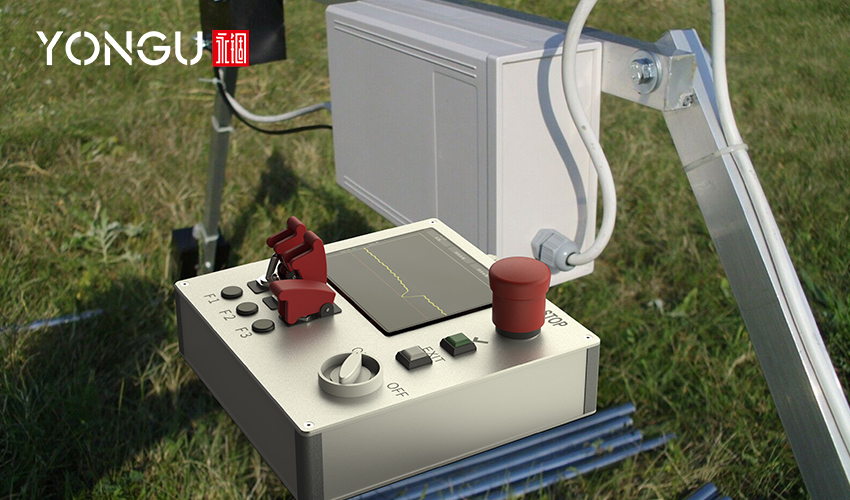WORKING OF GPR SYSTEMS
The principle of ground-penetrating radar is to transmit a short burst of electromagnetic energy into the earth and then analyze the returned signal for differences and anomalies. When entering the material, impulses cause reflections dependent on the conductivity and dielectric strength of the items within and around the material.
It is how it functions:
- Electromagnetic radiation is pulsed into the earth via a transmitter antenna.
- The dielectric and conductive characteristics of the earth and beneath objects deform this pulse as it travels through them.
- If the object is buried in the soil, the pulse will reflect the receiving antenna, displaying irregularities and differences between the object and the soil.

Electromagnetic waves may penetrate various materials, such as soil, concrete, granite, garbage, and water. Still, the reflection of these waves is affected by the varying conductive and dielectric qualities of these numerous different kinds of materials. The dielectric and conductive characteristics of the two materials govern the reflection's intensity and magnitude.
Multiple objects can be located with Ground Penetrating Radar waves. This subsurface instrument works best when there is a sizable gap between the target and background materials concerning their electromagnetic properties. Material types frequently mapped by GPR include metals, PVC, and other naturally derived materials.
UNDERSTANDING THE SCIENCE BEHIND GPR SYSTEMS
From these vantage points, we may discuss the physics and technology of ground-penetrating radar. Although operating a GPR system and deciphering the results may seem overwhelming at first, with enough experience and instruction, you'll be able to do so quickly. Learning the fundamentals of GPR systems and using that knowledge in practice can help you master the technology quickly.
Putting aside the science and technology involved, GPR systems rely on several instruments to conduct detailed surveys of subsurface materials. The following components are included in nearly every system:
- There are two antennae, one for sending and one for receiving signals.
- Data collection and analysis through computer and screen.
- The source of energy for running things.
Images and graphs depicting the underlying material's properties are shown on a computer screen after antennas emit electromagnetic waves, and the resulting wave distortions are monitored. The operator can then use this data to deduce the presence and kind of objects and their relative depths.
Underneath, the program does all the math needed to display precise values. For instance, the duration it takes for a signal to traverse from the sending antenna into the subsurface and reflect the receiving antenna is a critical factor in determining depth measurement accuracy.
It should be stressed that this information is neither uninteresting nor field-specific in its accessibility. Although real-time responses are integral to GRP, the information gathered may be shared and analyzed with others. Operators may gather massive volumes of data about the subsurface they are surveying and communicate it with co-workers using the appropriate GPR software. In addition, GPR systems may be integrated with other technologies like global positioning systems (GPS) and mapping tools. As a result, this can make large-area scanning more efficient and provide experts access to more information.
Although GPR technology has many applications, it is essential to fully comprehend the system before using it. Everything in the system, from the hardware to the programs running on the computer, works together to provide operators and experts with helpful information.
ENCLOSURE FOR GPR EQUIPMENT’S
The transmitters, receivers, and UPS systems installed remotely to support HF radars are frequently exposed to severe corrosive conditions.
Since these systems are frequently installed on ships or in coastal areas, they need to be shielded from elements like:

Since geo-radar equipment enclosures are designed to shield sensors responsible for autonomous driving, they should be put through their paces in some of the harshest mining conditions on the earth. They should be built with adaptability and ease of maintenance, with quickly replaceable components and cross-compatibility with other systems.
Sensitive machinery can be damaged by prolonged exposure to these corrosive atmospheric conditions. Equipment failure or malfunction can be avoided with the help of a weatherproof and temperature-controlled enclosure. The YONGU is a perfect case for geo-radar and other purposes enclosures since they are weatherproof and dustproof.
The following characteristics are recommended for them.
YONGU GEO-RADAR ENCLOSURES
Regarding aluminum and plastic enclosures, YONGU is a top contender. Whether it's heavy equipment, industrial facilities, the depths of the ocean, or the great outdoors, YONGU IP68 Waterproof Aluminium Boxes & IP67/IP68 aluminum enclosures are up to the challenge.
If you need an IP-rated enclosure for your geo-radar equipment, YONGU provides a vast selection ready to be customized to your specifications.
The most outstanding services, including customization possibilities, can be found at YONGU IP68 enclosures, where you may house your geo-radar equipment. Some of the models we're pleased to provide are:
In addition to other similarities, the two series have the following characteristics.
For further information and customized product of your requirements, please follow our FACEBOOK for more updates and informations.
You can also contact us at +86 13326782625 or write us [email protected].
Underneath, the program does all the math needed to display precise values. For instance, the duration it takes for a signal to traverse from the sending antenna into the subsurface and reflect the receiving antenna is a critical factor in determining depth measurement accuracy.
It should be stressed that this information is neither uninteresting nor field-specific in its accessibility. Although real-time responses are integral to GRP, the information gathered may be shared and analyzed with others. Operators may gather massive volumes of data about the subsurface they are surveying and communicate it with co-workers using the appropriate GPR software. In addition, GPR systems may be integrated with other technologies like global positioning systems (GPS) and mapping tools. As a result, this can make large-area scanning more efficient and provide experts access to more information.
Although GPR technology has many applications, it is essential to fully comprehend the system before using it. Everything in the system, from the hardware to the programs running on the computer, works together to provide operators and experts with helpful information.
ENCLOSURE FOR GPR EQUIPMENT’S
The transmitters, receivers, and UPS systems installed remotely to support HF radars are frequently exposed to severe corrosive conditions.
Since these systems are frequently installed on ships or in coastal areas, they need to be shielded from elements like:
- Extremely High Ambient Temperatures
- Fog
- Vibration and Resonance
- Weather with a High Proportion of Moisture
- Intense Direct Sunlight
- Sustained Gusts of Wind
- Rain and Snow

Sensitive machinery can be damaged by prolonged exposure to these corrosive atmospheric conditions. Equipment failure or malfunction can be avoided with the help of a weatherproof and temperature-controlled enclosure. The YONGU is a perfect case for geo-radar and other purposes enclosures since they are weatherproof and dustproof.
The following characteristics are recommended for them.
- IP ratings of at least NEMA 4X are required.
- Immune to corrosion
- Coatings of epoxy
- Advances in closed-loop thermoelectric solid-state air conditioning systems
- Protection from inclement weather with the available rain shroud.
- Configurations with two points of entry for easier access to machinery
- Rack rails, shelves, and sub-panels for installing electronics
- Security fasteners
Regarding aluminum and plastic enclosures, YONGU is a top contender. Whether it's heavy equipment, industrial facilities, the depths of the ocean, or the great outdoors, YONGU IP68 Waterproof Aluminium Boxes & IP67/IP68 aluminum enclosures are up to the challenge.
If you need an IP-rated enclosure for your geo-radar equipment, YONGU provides a vast selection ready to be customized to your specifications.
The most outstanding services, including customization possibilities, can be found at YONGU IP68 enclosures, where you may house your geo-radar equipment. Some of the models we're pleased to provide are:
- YONGU L Series: Durable enclosures rugged enough for indoor or outdoor applications.
- YONGU M Series: Highly versatile enclosures at an economical price
In addition to other similarities, the two series have the following characteristics.
- Made for the rigors of daily use.
- This dispensing ring is excellent for preserving either water or dust resistance.
- The enclosure is made of durable die-cast aluminum, which can withstand shocks.
- The contact between the raw interior surfaces can be used to create conductivity.
For further information and customized product of your requirements, please follow our FACEBOOK for more updates and informations.
You can also contact us at +86 13326782625 or write us [email protected].



